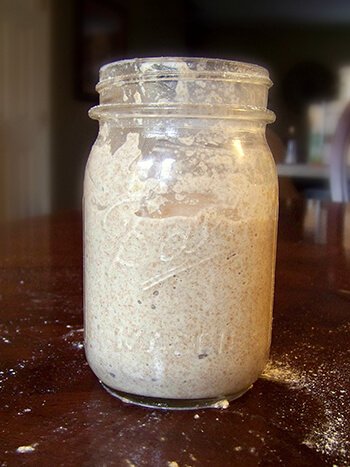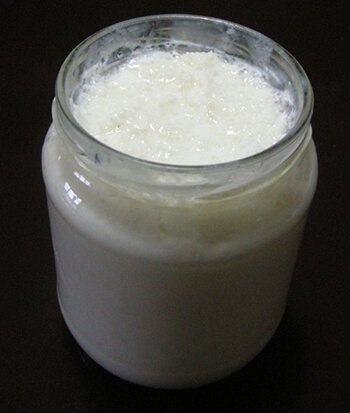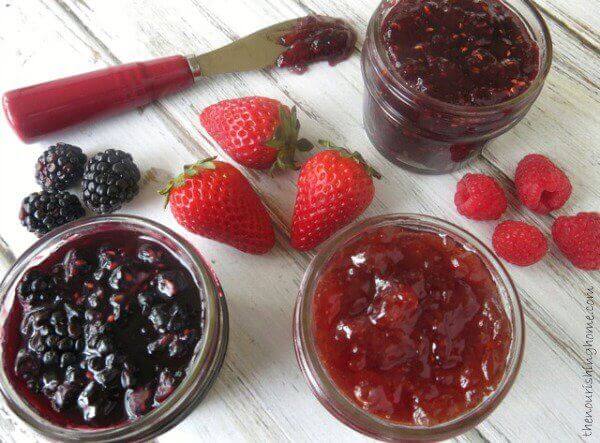6 Cultured Foods to Make at Home
Probiotics are a great way to keep your digestive system working properly. Lots of people take probiotics in pill form, but I love getting in as many probiotics as I can through my food and drinks.
What are the best foods to eat to fill your body up with all of those beneficial probiotics? Cultured and fermented foods! They are full of probiotics, and they are easy to make yourself at home.
Here are six different cultured foods that you can easily make at home to help your family have a steady supply of probiotics.
1. Yogurt
Yogurt is probably the most well-known cultured food in our society. The problem with most varieties that you find in the store is the fact that they are filled with artificial flavors and tons of sugar.
The solution? Make yogurt yourself at home! It’s really very simple, and there are several different methods that you can try. Pick the one that seems the easiest to you!
Homemade Slow Cooker Yogurt (this is the method that I use)
2. Milk Kefir
Milk kefir is similar to yogurt. It is not as thick as yogurt, and has a slightly more sour taste. It makes a wonderful base for smoothies!
To make milk kefir, you simply put kefir grains in a jar of fresh milk and let it culture at room temperature for around 24 hours. When it is done, strain the grains from the kefir and repeat the process.
Here is a detailed tutorial on making milk kefir, and here is a great source for obtaining milk kefir grains.
3. Water Kefir
Water kefir is a sweet, fizzy beverage that is very easy to make at home. The process for making water kefir is similar to that of making milk kefir.
To make water kefir, you begin with a sugar water mixture that you add water kefir grains to. You then let it sit at room temperature for around 24 hours. During this time the grains eat most of the sugar and leave you with a delicious water kefir. Then you simply strain out the grains and repeat the process for a daily supply of fresh water kefir.
Many people find water kefir helpful for giving up soda pop. It is a healthful beverage besides water that you can enjoy without all of the sugar and chemicals found in pop. Instead of those nasty things, it’s full of probiotics!
Here is a detailed tutorial on making water kefir, and here is a good source for getting your own water kefir grains.
4. Kombucha
Kombucha has a special place in my heart. Our whole family loves kombucha, and we really enjoy the process of making it together as a family. We lovingly refer to it as boocha, which is the name given to it by our son.
If you have never tried kombucha before, it may require a bit of time to aquire a taste for it. Depending on how long you ferment (or culture) it for, it can be a bit tart. We like ours to be more on the sour side, and we love flavoring it with different fruit flavors.
There are two different methods for making kombucha. The continuous brew method and the standard brew method. We started using the continuous brew method earlier this year, and it is definitely our favorite. This is the jar that we use (and love!) to brew our kombucha, and here is a detailed explanation for using the continuous brew method.
To obtain a SCOBY for making kombucha, you can purchase one, get one from a friend, or make one yourself from a store bought bottle of kombucha.

5. Sourdough
Sourdough seems to be intimidating to many people, but once you get the hang of it, it’s simple! We love using our sourdough starter to make bread, waffles, pancakes, and all sorts of other yummy goodies.
To get started with sourdough, you will either need to make your own sourdough starter or buy one. Once your sourdough is thriving, you will get into a rhythm of caring for it and then you will be making lots of yummy sourdough goodies to enjoy.
Here are some easy (and delicious) recipes to get you started.
Whole Wheat Sourdough Pancakes
Whole Wheat Sourdough Biscuits
If you’re still looking for more recipes, I own and love this Sourdough from A to Z book. It is loaded with sourdough recipes that I use over and over again.
6. Lacto-fermented Vegetables
I don’t have a lot of experience with lacto-fermented vegetables, but I have loved everything that I have been able to make up to this point. I am excited about using lacto-fermentation to preserve a lot of our garden bounty in the upcoming year.
Here are a list of simple lacto-fermented veggies for you to try yourself.
Lacto-Fermented Salsa (this is delicious!)
Do you make any cultured foods at home? What are your favorite ways to get more probiotics in your diet?









I think you’ve sold me on Boocha….except that I hate tea. 😉
Homebrewed kombucha is cheap and easy. You might like it because it doesn’t taste like tea at all. We like ours on the tart and fizzy side — which we make by just putting in some frozen berries after I bottle the brew.
But I don’t think it tastes like tea, really. Especially if you flavor it with fruit or juice. Love that you called it Boocha. That’s what my 3 year old called it and so now we all refer to it that way. 🙂
I am learning to have a great respect for cultured foods. I do have an heirloom SF Sourdough starter that I feed every week. I keep it in the fridge but don’t bake bread with it very often since I haven’t found a good bread recipe for the bread machine for sourdough bread, and it takes a long time to make regular sourdough bread, time I don’t have much of!
Yogurt also takes a long time. It may be simple, but there are more steps to making it than making kefir, so I stick with kefir for my probiotic drink. Now THAT is simple to make. 🙂 I get raw milk from a local farm and boy is it good.
I JUST STARTED my first batch of lacto-fermented veggies. Thank you so much for these tips and recipes because this week I will be able to taste my creation, and I hope it tastes good. I got a fermentation crock for Christmas, and shredded cabbage and carrots, so we will see how it turns out 🙂 I can’t wait to try other things. But my plan is to eat a few tablepoons throughout each day. I hope I like it because I am a bit weird with tastes.
Since the eBook giveaway, I’ve been successfully making all sorts of sourdough items! I have a bowl of dough in the kitchen waiting to become a loaf of bread. I like making yogurt as well, but a source of affordable *good* milk is making that difficult right now. Recently, a friend said she would share a scoby with me, so I’m going to be trying out some “boocha” soon. Slowly but surely, I’m getting more fermented stuff into the family diet. Okay, time to go make some sourdough pancakes for breakfast!
I made yogurt using the crockpot method and milk kefir for well over a year in North Carolina. it always turned out wonderful. I moved to Amarillo, Texas 5 months ago and now I have had zero luck making either one. I have tried yogurt a handful of times and each time it looks like yogurt but tastes bland and uncultured. I tried kefir for about 6 weeks and everytime it would spoil or smell funny. Have you ever heard of places that were just not able to culture foods?
I too was using milk Kefir in CO but when I moved to TX I ended up throwing it out. Our house was kept at a much higher temperature in TX and after reading that kefir could grow mold, and it didn’t look like it had in CO, I sadly tossed it down the drain.
I live in subtropical Australia, and I don’t really make milk kefir over the summer here. It ferments very quickly, often overnight, and I can’t keep up with it. I make water kefir in summer, and if I do want to make milk kefir, I watch it carefully and as soon as it has fermented to the point we like, I put it in the fridge. That slows the ferment down so it doesn’t spoil so fast.
Every place can culture foods but you might find that what works in one area doesn’t in another, due to factors like temperatures, humidity and elevation. I would experiment with different methods to find one that works, or ask some locals 🙂
Thanks so much for this great article!! I’m wondering, when you make kefir and strain out the grains, then you say repeat the process, how many times can you reuse the same grains? Are kefir grains something you need to keep purchasing?
Kefir grains are reusable over and over again. The only thing is that you have to keep them alive by making a new batch often. I used to make water kefir and was successful with the same grains for about half a year, then they died because I didn’t have time to keep up with it when my second baby was born. I much prefer brewing Kombucha over making water kefir. It only needs to be done every 7 – 21 days (depending on the room temperature). I think I had to make water kefir every 2 days and milk kefir needs to be daily (although I haven’t tried making it myself).
I have been using a sourdough starter for a few months now and I love it! I also make yogurt at home. I have the grains for kefir but haven’t rehydrated them…yet. Maybe in 2013! Lacto-fermentation-well I am just nowhere close to trying that. I guess I don’t ‘get it’ yet. I would definitely recommend the sourdough e book.
I make a few jars of lacto-fermented veggies every 2 weeks…my 10 year old eats it as well. Amen! I buy kefir and kombucha so my goal in the New Year is to make my own. I’ve tried to make sourdough bread but I need a better recipe since mine turned out like bricks!
Thanks to the Healthy Living ebook bundle, I got a buttermilk starter and have been making buttermilk at least once a week. It’s great because I don’t have to buy a carton at the store anymore that’s too big for us; I can make as little as 1 cup or as much as a quart.
I make water kefir. Tried apple kefir too – definitely can taste the ferment in that! Also do kombucha. My husband really likes the ginger kombucha. I am liking lime (I put in organic peel and honey). and mango. am trying a coffee one right now. It is in the process now. will see in a couple of days if it is worth it! I just love trying new flavours!!! but always do the ginger for hubby!!
I am definitely going to come back and try some of these recipes. I have heard so much about the benefits of fermented foods but have never tried them myself. Thanks for all the great info!
My son, who hates all vegetables, will ask me to make saurkraut. He will not touch the stuff from the store.
I’ve been making kombucha for about 6 months now. We love it! I’ve only had store-bought twice and didn’t care for it. All of my friends are hooked on mine, too, and prefer it over the store-bought. I must be doing something right. :0) I’ve also done milk kefir for a very long time but I may have killed it since it’s been (dormant) in my fridge for a long time. We’ve also done some lacto-fermented veggies. I have kimchi and pickles in the fridge right now and would like to find a good recipe for carrots. Haven’t ventured into sourdough yet; I’m too intimidated!
I’ve been wanting to try making Kombucha for a while now, but haven’t gotten around to it…busy season! Anyways, my question is concerning bottling it. I know that several sites sell “drinking” bottles that you are supposed to bottle your brew in (they are generally suggested to be an amber color if I”m remembering correctly), but they are quite pricey. Do you have to use these? Can I use quart mason jars to store it in once it’s done? And, once it’s brewed, do you store it in the fridge…how long will it last without going bad? Do you add whole berries, pureed, any kind of fruit, etc. Okay…sorry, that ended up being quite lengthy! :0) Thanks for your response in advance!